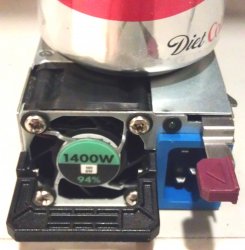Just to elaborate, the math is quite interesting.
The 450 watt 90% power supply in the MP6,1 has the following characteristics:
- it supplies a continuous 450w DC to the computer
- it draws 500w of power from the mains
- it produces 50w of heat to be dissipated
A 94% efficiency power supply like the HP in my picture that produced 50 watts of heat would:
- supply 785w to the computer
- draw 835.1 watts from the mains
- produce 50.1 watts of heat
A 96% efficiency power supply that produced 50 watts of heat would:
- supply 1200w to the computer
- draw 1250 watts from the mains
- produce 50 watts of heat
(Think about it - a 100% efficient power supply would supply infinite power and produce no heat.)
So, the issue is
*not* cooling the power supply. Just increasing the efficiency of the power supply to what is easily available on the open market would nearly triple the available power.
So the question becomes, assuming that the vaunted "thermal core" could dissipate additional heat with more airflow, do you want:
- an underpowered nnMP that is always quiet
- a much faster nnMP that has audible airflow when pushed hard
And it doesn't even have to be an "either-or" question. The power setting control panel on my laptop let's me choose "reduce performance to stay quiet" or "spin the fans up for max performance".





